Plant Size Guide
Our guide to understanding nursery plant sizes explains the differences between container sizes, caliper measurements, and height listings. Learn how each measurement works, why it matters, and how to choose the right size for your project.
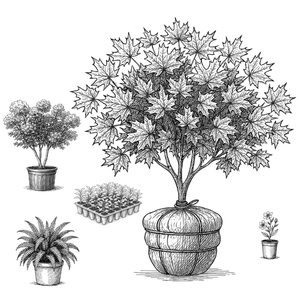
Understanding Our Plant Sizes & Measurements
When you’re shopping for plants, you’ll see a lot of numbers next to names: container sizes, caliper measurements, and heights in feet or inches. We know it can feel like learning a new language, so we’re here to translate.
At Plant Detectives, we list plant sizes in three main ways:
- Container Size (1 Gallon, 5 Gallon, 25 Gallon, etc.)
- Caliper (trunk diameter for trees)
- Height (inches or feet)
The variety exists because plants grow in different ways. Some are raised in pots, others in the ground. Some have a single trunk, while others are multi-stemmed. In general, the larger the number, the more mature the plant.
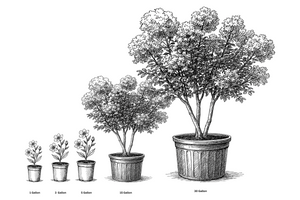
Container Grown
Container-grown plants spend their early lives in sturdy plastic pots. They are lighter, easier to transport, and available outside standard digging seasons, which means you can get them almost any time of year.
Here’s the quick math:
- Smaller container number (1 Gallon, 3 Gallon, 5 Gallon) means younger, lighter, and more budget-friendly
- Larger container number (25 Gallon, 45 Gallon, 75 Gallon) means more mature, heavier, and a higher investment
A quick side note: when we say “Gallon,” it is more of a nursery nickname than a precise measurement. A 5 Gallon container does not actually hold five gallons of soil, and sizes can vary slightly between container manufacturers.
Perennials (including grasses and herbaceous plants) are sold in containers, most often in smaller sizes, but you’ll see everything from tiny plugs to 5 Gallon containers or more.
Trees, shrubs, and evergreens can also be sold in containers, usually ranging from 3 Gallon up to 100 Gallon or more. Beyond that, they're also measured by height.
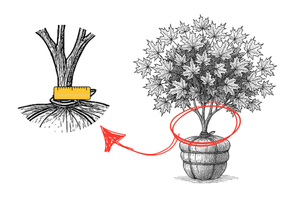
Balled & Burlapped (B&B) and Caliper Sizes
Field-grown trees and larger evergreens are measured by caliper, the diameter of the trunk in inches, taken six inches above the root flare (where the trunk meets the roots).
When these trees are dug, the root ball is wrapped in burlap, held in a wire basket, and secured with twine. This is called balled & burlapped (B&B). These trees have spent years growing in open fields, developing strong root systems, which makes them more resilient once transplanted.
- 1.5 inch to 2.5 inch caliper refers to smaller field-grown trees, often transportable without heavy machinery
- 3 inch caliper and up refers to larger, heavier trees that often require equipment to transport
- Some specimen trees can be 6 inch or more, weighing several thousand pounds and requiring specialized handling
Digging timing matters. Some trees, such as birch and oak, can only be dug in spring, while others, such as maples, can be dug in both spring and fall. This is why availability changes throughout the year and why pre-ordering seasonal trees can be a smart move.
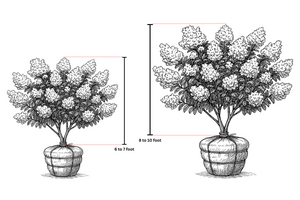
Height Measurements
For many shrubs and evergreens, height is the primary measurement, even when they are still in containers. Height is most often used when a plant does not have a single, clearly defined trunk, such as clump-form or multi-stem plants. In these cases, measuring trunk diameter (caliper) is not practical, so we measure from the top of the root ball to the top of the plant. Heights are typically listed in ranges (example: 5 to 6 foot)
As with caliper, greater height generally means a more mature plant, with more weight, presence, and cost.
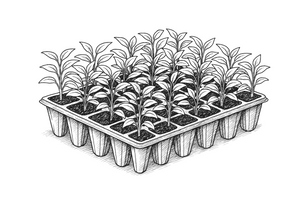
Plugs: Tiny Powerhouses in Training
Here’s a little secret: the youngest plants can be the mightiest. Plugs are miniature seedlings started in soil-filled cell trays. It’s where plants begin their journey, building the roots they’ll need to thrive long-term. Each plug contains a healthy root system holding the growing medium intact, which is a major advantage when transplanting.
Plugs are often grown for just a few months, depending on species, before they are planted out or moved into larger containers. They are cost-effective, space-saving, and ideal for dense plantings or areas with limited planting access.
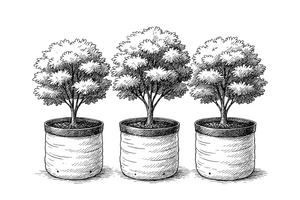
Other Container Options
While we do not normally carry these at Plant Detectives, you may encounter other container types:
- RootMaker Containers: Specialized pots that use air-pruning and vented sidewalls to prevent roots from circling inside the container. This encourages a dense, fibrous root system that establishes quickly after planting.
- Grow Bags: Fabric containers that allow air and moisture to move through the root zone. They naturally prune roots, reduce transplant shock, and can make larger plants easier to transport than traditional B&B stock.
Knowing these terms can help you compare options when shopping elsewhere or deciding which planting method works best for your project.
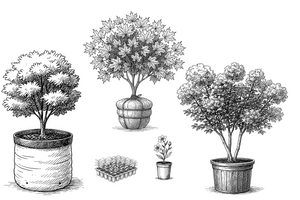
Why Size Matters
Bigger plants provide more immediate visual impact; they are closer to their mature form and can create an instant focal point in your landscape. Smaller sizes are more affordable, easier to plant, and often adapt faster to their new home.
No matter the size, every plant we sell is grown to meet our quality standards so it will thrive in your landscape for years to come.
